Jason Schneider
the Camera Collector
The Most Beautiful Cameras Ever Made, Part 1
Interchangeable lens rangefinder 35mm film camerass, the elite class.
By Jason Schneider
“Beauty is in the eye of the beholder,” is an elegant way of saying that beauty is inherently subjective. Or as the Romans put it, De gustibus non est disputandum(there’s no disputing taste). When it comes to cameras, picking out the beautiful sheep from the ungainly goats and the pedestrian cattle is complicated by the fact that cameras are functional objects, and the way they embody that functionality has a lot to do with our esthetic judgments. For example, some cameras have the look of precision machinery, and so long as their many dials, knobs, and levers are well integrated and visually balanced, we perceive them as beautiful. Other cameras we deem beautiful are sleek and streamlined, embodying a kind of minimalist elegance. Finally, many enthusiasts cite the oft quoted Bauhaus dictum “form follows function” when asked why they’ve included specific cameras on their “most beautiful” list. Emotions have a lot to do with our perceptions of beauty too—we’re more likely to see cameras that marked transitions in our lives or in our approach to photography as beautiful.
Bearing all these subjective imponderables in mind, I will go boldly where angels fear to tread and offer my own unflinching selections as the most beautiful cameras of all time, starting with one of my favorite categories—interchangeable lens rangefinder 35s. I’m braced for a barrage of outraged responses from those who vehemently disagree with my choices, but hey, this is all done in the name of fun, and there are no “right answers” to this ever fascinating question.
Interchangeable lens rangefinder 35s
Nikon S2: The Nikon S2 of 1955 is the prettiest Nikon rangefinder camera, and arguably the most elegantly understated interchangeable lens rangefinder 35 ever made. The first Nikon to adopt the standard 24 x 36 mm format, its advances ever the previous Nikon S include a bright 1:1 viewfinder with a fixed reflected frame line covering the 50mm field, a single-stroke film wind lever, a folding rewind crank, a top shutter speed of 1/1000 sec, and a single bottom opening key. Visually it’s a beautifully balanced design that’s more assertive than the spartan, small-windowed Nikon S, but less visually “complex” than the top-of-the-line Nikon SP of 1957. Most Nikon Illuminati prefer the rarer version of the S2 which has a striking black shutter speed dial in place of the standard chrome one, and the gorgeous factory black painted S2 is the ultimate collector’s prize.
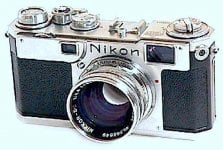
Nikon S2 of 1955: A masterpiece of elegant design, it was Nikon's first rangefinder 35 with standard 24 x 36mm format, 1:1 frame line finder, and lever wind.
The Nikon SP, designed as a Leica M3 beater, is certainly the most advanced rangefinder camera Nikon ever produced. And to many Nikon fans and collectors its distinctive large viewfinder window that’s easily recognizable from across a large room also make it the most beautiful rangefinder Nikon ever. As a shooter’s camera it certainly excels with a 1x magnification main viewfinder with parallax-compensating frame lines for 50mm, 85mm, 105mm, and 135mm lenses (selected by rotating a dial under the rewind crank) and a separate, smaller viewfinder to the left of the main viewfinder with a fixed frame line for 35 mm lenses. The entire window acts as a frame for 28 mm lenses. The SP doesn’t have a hot shoe, but it does provide a PC terminal. Early models have rubberized silk fabric shutter curtains, but in 1959 the shutter curtains were changed to titanium like the Nikon F. The Nikon SP was also the first rangefinder camera to offer an electric motor drive, the S-36, which could advance the film at 3 fps, a feature much appreciated by photojournalists and action photographers.
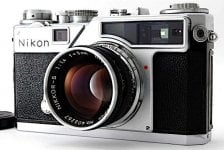
Nikon SP of 1957: Distinctively styled with big front window, Nikon's most advanced rangefinder 35 has a comprehensive frame line system, and much more.
A clean Nikon S2 in chrome with 50mm f/1.4 Nikkor-S.C lens is currently priced at about $600 on the major online auction sites. A clean Nikon SP similarly equipped in chrome fetches $700-$1,300, and around $5k in original factory black in near mint condition.
Leica M3: The iconic Leica M3 of 1954 defined the modern system rangefinder camera with its true projected, parallax-compensating, auto indexing frame lines for 50mm, 90mm and 135mm lenses. It also introduced the M mount, was the first Leica with a film wind lever (first 2-stroke, then 1-stroke), and it has a hinged back door to facilitate loading. In terms of its physical design the Leica carried forth such signature Leica features as the basic Leica form factor with ergonomically rounded ends, and a traditional rewind knob. Its proportions and visual balance are superb, with such masterful touches as raised frames around the front rangefinder and viewfinder windows, an elegantly contoured wind lever, and a single top-mounted, non-rotating shutter speed dial. Even Nikon and Canon, its leading competitors, never surpassed the Leica M3 and it’s considered by many to be the most beautiful Leica M ever. Leica M3 bodies in chrome in excellent or better condition currently fetch about $1,500-$2,000, but pristine examples with 50mm f/2 Summicron or 50mm f/1.4 Summilux lenses can bring $4 000.00-$5,000 depending on the particulars.
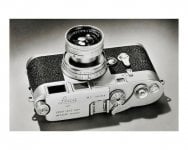
Leica M3 of 1954: Gorgeous early 2-stroke example with collapsible 50mm f/2 Summicron showcases its masterfully integrated, superbly functional design.
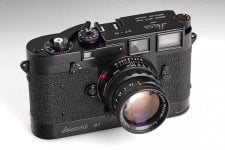
Original Leica MP of 1956: Limited edition sold to top photojournalists was an M3 variant with ruggedized internals, a manually set M2 style frame counter and a matching Leicavit MP rapid winder. Most of these cameras saw hard use, and ultra-rare pristine examples like this one have fetched close to $2M at auction!
Leica Special Editions – while some Leica Special Editions are real stinkers, a few are downright beautiful, including but not limited to:
The Leica M6J, is a Special Edition 40[SUP]th[/SUP] Anniversary Leica M (total production 1,640 cameras) commemorating the debut of the M3 in 1954. An exquisite piece of craftsmanship it includes the classic M3 ridged frame lines around the front windows in the top plate, a vintage metal preview lever, a chrome plated lens release button, anf the classic Leicas script logo on top, above the inscription “40 Jahre Leica M 1954-1994.” But unlike the M3, the M6J has TTL metering, a hot shoe, a motor drive connection, an angled M4-stylerewind crank, and of course an M6 style cover for the battery compartment on the front. It uses a .85x magnification finder instead of the M3’s 0.91x finder, providing nearly equivalent focusing accuracy, and it adds a 35mm frame line, which the M3 never had (but alas no 75mm frame line). It even came with a classic style chrome lens cap for the special 50mm f/2.8 collapsible Elmar-M lens that was part of the kit, and the lens is engraved with a serial number that matches the camera. The special serial number of each M6J denotes a year in the M production range (from 1954-1994) plus a number range of 1 to 40 for each of those years. Once the M6J sold out, the Leica factory was besieged with requests for a regular production M6 with the .85x finder and they finally made it available 4 years later. The complete M6J outfit includes the camera with matching collapsible 50mm f/2.8 Elmar-M, a wooden presentation case, a classic style lens cap and shade, a specially made vintage case, and a certificate of authenticity. Prices for Leica M6J outfits started high and are now stratospheric--in the $11,000-$15,000 range for a pristine outfit based on current online auction listings
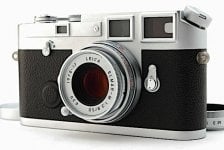
Leica M6J: Special limited edition of 1994 commemorates the 40th Anniversary of the M3 with several classy styling licks. It's one of the prettiest Leica Ms.
The Leica M6 was also produced in several themed limited editions, all of which are truly beautiful cameras.
The Leica M6 Jaguar of 1998 was a very limited edition of only 50 cameras celebrating the 50[SUP]th[/SUP] Anniversary if the Jaguar XK120 automobile. It’s based on the standard M6, includes a collapsible 50mm f/2.8 Elmar-M lens, has a handsome Jaguar XK engraving on top and a special XK series number inscribed on the accessory shoe, and is clad in (what else?) British Racing Green Connolly leather. It was originally offered at a cool $9,240.00 and is now hard to find even on the leading auction sites.
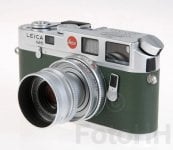
Leica M6 TTL Jaguar XK Limited Edition of 1998 was one of 50 made to commemorate the 50th Anniversary if the Jaguar XK120. It's expensive!
Leica M6 TTL LHSA: This exquisite black paint M6 TTL with Leica script logo on top, LHSA logo and “LEICA SPECIAL EDITION” on the back, and a black version of the red Leica dot next to the frame line illumination window on the front, was produced at the behest of the Leica Historical Society of America and available only to LHSA members (though you could join to buy the camera!). Instead of using standard magnesium M6TTL parts special parts had to be machined from brass to take the paint properly. No lens was supplied with the camera, but you could specify a 72x or .85s viewfinder. It was the first Leica engraved “Leica Camera AG, Solms, Germany.” Prices for a pristine Leica M6TTL LHSA body range from $13K to $17K, representing a pretty good return ion your (hefty) investment.
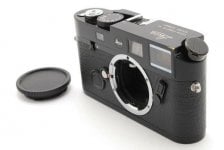
Leica M6TTL LHSA Special Edition: Note black Leica "red dot" on the front. LHSA logo is inscribed on the back of the camera,
Leica M6 TTL Olive: Leica also made a numbered limited edition of 300 M6TTL cameras, at least some of which have .85x finders, painted in stunning shade of olive green As you might expect they’re quite rare and command wallet bending prices, but for the less well heeled, exquisitely repainted versions of the M6TTL and other Leica Ms in olive, black and other colors are offered at inline auction sites at prices in the $2,000-$4,000 range.
Contax IIa: A complete redesign of the Contax II of 1936 The Contax IIa of 1950-61 had a simplified, much more reliable vertical roller blind shutter with nylon straps connecting the curtains and slats made of duraluminum. It’s also smaller, considerably lighter, and has more refined proportions than its illustrious prewar predecessor, albeit resulting in a somewhat shorter rangefinder base length. Along with its less attractive sister the Contax IIIa (which added a klutzy uncoupled selenium meter housing on top) the Contax IIa is functionally the best Contax Zeiss-Ikon ever made, and it’s complemented by a full line of superlative Zeiss bayonet mount lenses. Two variations of the Contax IIa/IIIa were produced: the “black dial” and “color dial” based on the color of the shutter speed numerals. The black dial uses special flash cords for bulb or electronic flash; the “color dial” has a PC outlet and provides X sync at 1/50 sec. Sadly both the Contax IIa and IIIa ceased production in 1960 and were gone by 1961. The Contax IIa is a gorgeous, beautifully proportioned machine with distinctive “cut corner” ends in the Contax rangefinder tradition dating back to the Contax 1 of 1932, It exudes an understated elegance and has an aura of precision that accurately reflects its impressive performance potential in the field. The Contax IIa is a superb user collectible that currently goes for $300-700 in clean to flawless condition with 50mm f/2 or f/1.5 Sonnar lens.
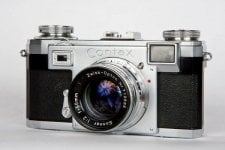
Contax IIIa of 1950-1961, shown with coated 50mm f/2 Sonnar, is an elegant, beautifully integrated design. Unfortunately its features were never updated.
Canon VL: All Canon screw mount rangefinder cameras are quite attractive, with the sole exception of the Canon 7, which has a large ugly selenium meter cell grid around the front rangefinder window. However, in my opinion the most elegant members of the breed are the limited production (7,975 cameras made) Canon L1 of 1957 and its even less common sister, the Canon VL (5,450 cameras made) of 1956-1958. Both are lever-wind iterations of the trigger wind Canon VT, and they have 3-position viewfinders (50mm, 35mm and RF), and separate fast (rotating) and slow (fixed) shutter speed dials. The L1 has a cloth focal-plane shutter with speeds of 1-1/1000 sec plus B and sports a nesting rewind crank in lieu of a knob. The VL looks almost identical, but its shutter has metal curtains, and it includes a front-mounted self-timer lever. Both these cameras have gorgeously contoured film wind levers, and their bodies are beautifully balanced and proportioned with Canon’s signature “half hex” ends. They look great with Canon’s classic rigid black barrel 50mm f/1.8 and even better with the larger diameter 50mm f/1.4 or f/1.2 Canon. Price range: Canon VL (or VL2 with 1/500 sec. top speed) $150-$200, body only in chrome in clean condition. Canon L1 body only, in chrome in clean condition, $250-275. The later Canon VI-L and Canon P (both 1958-1961) are also gorgeous cameras available at relatively moderate prices ($300-400 and $200-300 respectively. Chacun à son goût!
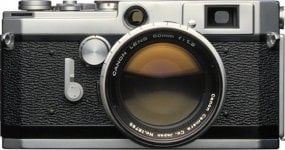
Canon VL of 1956-1958, here with 50mm f/1.2 Canon, is one of the prettiest screw-mount Canons. The Canon L1 of 1957 looks similar but has no self-timer.
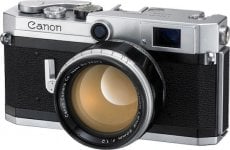
Canon VI-L of 1958-1961, the last of the classic meter less screw-mount Canons, is drop dead gorgeous and has a single coin-rotating shutter speed dial.
Finally, here are 2 well-made, beautifully proportioned off-the-wall choices in this elite camera category. Both rare vert pretty, but rare and priced accordingly.
The Robot Royal 36S of 1955-1976 was the only camera produced by Robot-Berning of Germany designed to cover the standard 24 x 36mm 35mm format. Like all Robots it features spring motor drive (via a bottom mounted winding key) and it can take up to 24 frames at 4 fps in burst mode using standard 35mm cartridges. It employs a larger version of the classic Robot behind-the-lens rotary shutter (with speeds of 1/2-1.500 sec plus B), a combined, coupled range/viewfinder (alas, no frame lenes) and it accepts 8 bayonet-mount German lenses by Schneider, Enna, and Zeiss ranging from 24mm to 200mm. A multifocal zooming accessory viewfinder was available.
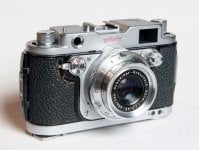
Robot Royal 36S of 1955-1976 features a built spring motor drive capable of 4 fps bursts. It's a masterpiece of "form follows function" design but quite heavy.
The Robot Royal 36S is gorgeously finished in satin chrome, ergonomically contoured with Leica-like rounded ends, well balanced for handholding, and its rangefinder has a 6cm baseline assuring accurate focusing with fast or long lenses. The downsides: it only accepts hard to find Robot bayonet mount lenses, it’s heavy—720 grams, body only, and a whopping 1030 grams (36.3 ounces!) with 50mm f/2 Sonnar lens, and it’s expensive! By the way, that 50mm f/2 Zeiss Sonnar was one if the sharpest lenses ever tested by Modern Photography. Current price range: $1,000-$1,800 for a Robot Royal 36S in clean working condition with normal lens, any type.
Steinheil Casca II: Steinheil’s 1948 masterpiece was the most advanced rangefinder 35 of the immediate postwar era, pioneering true projected (but non parallax compensating) viewfinder frame lines 6 years prior to the release of the landmark Leica M3 of 1954. It’s also a very beautiful, elegantly proportioned camera, a timeless classic. The list of its astonishing features include projected bright lines covering the field for 85mm and 135mm lenses (no 50mm frame), an innovative quick turn (10°), ball bearing channel lens mount, a convenient back-mounted, sliding bar for setting the (cloth focal plane) shutter for speeds of 1/2 10 1/1000 sec plus B, a range of flash sync settings for bulbs and electronic flash, large wind and rewind knobs (but no wind lever),and a bottom-hinged back for super convenient loading. Steinheil lenses include a 35mm f/4.5 Orthostigmat, 50mm f/2.8, \85mm f/2.8, and 145mm f/4.5 Culminars, and the elusive 50mm f/2 Quinon I’ve never actually seen in the glass and metal. If you can find a Steinheil Casca II, expect to fork over $1,500-$2,500 for a working model with one or two lenses (any type).
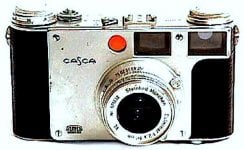
Steinheil Casca of 1948 had projected viewfinder frame lines 6 years before the Leica M3 and many other advanced features. It's also a beautiful camera.
Final note: In general, factory black finished versions of most interchangeable lens rangefinder 35s look simply gorgeous so long as they’re in mint condition, and command higher prices than chrome ones. Exceptions: Barnack (screw mount) Leicas such as the Leica II (model D) of 1932, where the default finish was black enamel. However, if you’re a fastidious user collector, chrome finished cameras are far less likely to show wear than black ones if they’re carefully used.
Interchangeable lens rangefinder 35mm film camerass, the elite class.
By Jason Schneider
“Beauty is in the eye of the beholder,” is an elegant way of saying that beauty is inherently subjective. Or as the Romans put it, De gustibus non est disputandum(there’s no disputing taste). When it comes to cameras, picking out the beautiful sheep from the ungainly goats and the pedestrian cattle is complicated by the fact that cameras are functional objects, and the way they embody that functionality has a lot to do with our esthetic judgments. For example, some cameras have the look of precision machinery, and so long as their many dials, knobs, and levers are well integrated and visually balanced, we perceive them as beautiful. Other cameras we deem beautiful are sleek and streamlined, embodying a kind of minimalist elegance. Finally, many enthusiasts cite the oft quoted Bauhaus dictum “form follows function” when asked why they’ve included specific cameras on their “most beautiful” list. Emotions have a lot to do with our perceptions of beauty too—we’re more likely to see cameras that marked transitions in our lives or in our approach to photography as beautiful.
Bearing all these subjective imponderables in mind, I will go boldly where angels fear to tread and offer my own unflinching selections as the most beautiful cameras of all time, starting with one of my favorite categories—interchangeable lens rangefinder 35s. I’m braced for a barrage of outraged responses from those who vehemently disagree with my choices, but hey, this is all done in the name of fun, and there are no “right answers” to this ever fascinating question.
Interchangeable lens rangefinder 35s
Nikon S2: The Nikon S2 of 1955 is the prettiest Nikon rangefinder camera, and arguably the most elegantly understated interchangeable lens rangefinder 35 ever made. The first Nikon to adopt the standard 24 x 36 mm format, its advances ever the previous Nikon S include a bright 1:1 viewfinder with a fixed reflected frame line covering the 50mm field, a single-stroke film wind lever, a folding rewind crank, a top shutter speed of 1/1000 sec, and a single bottom opening key. Visually it’s a beautifully balanced design that’s more assertive than the spartan, small-windowed Nikon S, but less visually “complex” than the top-of-the-line Nikon SP of 1957. Most Nikon Illuminati prefer the rarer version of the S2 which has a striking black shutter speed dial in place of the standard chrome one, and the gorgeous factory black painted S2 is the ultimate collector’s prize.

Nikon S2 of 1955: A masterpiece of elegant design, it was Nikon's first rangefinder 35 with standard 24 x 36mm format, 1:1 frame line finder, and lever wind.
The Nikon SP, designed as a Leica M3 beater, is certainly the most advanced rangefinder camera Nikon ever produced. And to many Nikon fans and collectors its distinctive large viewfinder window that’s easily recognizable from across a large room also make it the most beautiful rangefinder Nikon ever. As a shooter’s camera it certainly excels with a 1x magnification main viewfinder with parallax-compensating frame lines for 50mm, 85mm, 105mm, and 135mm lenses (selected by rotating a dial under the rewind crank) and a separate, smaller viewfinder to the left of the main viewfinder with a fixed frame line for 35 mm lenses. The entire window acts as a frame for 28 mm lenses. The SP doesn’t have a hot shoe, but it does provide a PC terminal. Early models have rubberized silk fabric shutter curtains, but in 1959 the shutter curtains were changed to titanium like the Nikon F. The Nikon SP was also the first rangefinder camera to offer an electric motor drive, the S-36, which could advance the film at 3 fps, a feature much appreciated by photojournalists and action photographers.

Nikon SP of 1957: Distinctively styled with big front window, Nikon's most advanced rangefinder 35 has a comprehensive frame line system, and much more.
A clean Nikon S2 in chrome with 50mm f/1.4 Nikkor-S.C lens is currently priced at about $600 on the major online auction sites. A clean Nikon SP similarly equipped in chrome fetches $700-$1,300, and around $5k in original factory black in near mint condition.
Leica M3: The iconic Leica M3 of 1954 defined the modern system rangefinder camera with its true projected, parallax-compensating, auto indexing frame lines for 50mm, 90mm and 135mm lenses. It also introduced the M mount, was the first Leica with a film wind lever (first 2-stroke, then 1-stroke), and it has a hinged back door to facilitate loading. In terms of its physical design the Leica carried forth such signature Leica features as the basic Leica form factor with ergonomically rounded ends, and a traditional rewind knob. Its proportions and visual balance are superb, with such masterful touches as raised frames around the front rangefinder and viewfinder windows, an elegantly contoured wind lever, and a single top-mounted, non-rotating shutter speed dial. Even Nikon and Canon, its leading competitors, never surpassed the Leica M3 and it’s considered by many to be the most beautiful Leica M ever. Leica M3 bodies in chrome in excellent or better condition currently fetch about $1,500-$2,000, but pristine examples with 50mm f/2 Summicron or 50mm f/1.4 Summilux lenses can bring $4 000.00-$5,000 depending on the particulars.

Leica M3 of 1954: Gorgeous early 2-stroke example with collapsible 50mm f/2 Summicron showcases its masterfully integrated, superbly functional design.

Original Leica MP of 1956: Limited edition sold to top photojournalists was an M3 variant with ruggedized internals, a manually set M2 style frame counter and a matching Leicavit MP rapid winder. Most of these cameras saw hard use, and ultra-rare pristine examples like this one have fetched close to $2M at auction!
Leica Special Editions – while some Leica Special Editions are real stinkers, a few are downright beautiful, including but not limited to:
The Leica M6J, is a Special Edition 40[SUP]th[/SUP] Anniversary Leica M (total production 1,640 cameras) commemorating the debut of the M3 in 1954. An exquisite piece of craftsmanship it includes the classic M3 ridged frame lines around the front windows in the top plate, a vintage metal preview lever, a chrome plated lens release button, anf the classic Leicas script logo on top, above the inscription “40 Jahre Leica M 1954-1994.” But unlike the M3, the M6J has TTL metering, a hot shoe, a motor drive connection, an angled M4-stylerewind crank, and of course an M6 style cover for the battery compartment on the front. It uses a .85x magnification finder instead of the M3’s 0.91x finder, providing nearly equivalent focusing accuracy, and it adds a 35mm frame line, which the M3 never had (but alas no 75mm frame line). It even came with a classic style chrome lens cap for the special 50mm f/2.8 collapsible Elmar-M lens that was part of the kit, and the lens is engraved with a serial number that matches the camera. The special serial number of each M6J denotes a year in the M production range (from 1954-1994) plus a number range of 1 to 40 for each of those years. Once the M6J sold out, the Leica factory was besieged with requests for a regular production M6 with the .85x finder and they finally made it available 4 years later. The complete M6J outfit includes the camera with matching collapsible 50mm f/2.8 Elmar-M, a wooden presentation case, a classic style lens cap and shade, a specially made vintage case, and a certificate of authenticity. Prices for Leica M6J outfits started high and are now stratospheric--in the $11,000-$15,000 range for a pristine outfit based on current online auction listings

Leica M6J: Special limited edition of 1994 commemorates the 40th Anniversary of the M3 with several classy styling licks. It's one of the prettiest Leica Ms.
The Leica M6 was also produced in several themed limited editions, all of which are truly beautiful cameras.
The Leica M6 Jaguar of 1998 was a very limited edition of only 50 cameras celebrating the 50[SUP]th[/SUP] Anniversary if the Jaguar XK120 automobile. It’s based on the standard M6, includes a collapsible 50mm f/2.8 Elmar-M lens, has a handsome Jaguar XK engraving on top and a special XK series number inscribed on the accessory shoe, and is clad in (what else?) British Racing Green Connolly leather. It was originally offered at a cool $9,240.00 and is now hard to find even on the leading auction sites.

Leica M6 TTL Jaguar XK Limited Edition of 1998 was one of 50 made to commemorate the 50th Anniversary if the Jaguar XK120. It's expensive!
Leica M6 TTL LHSA: This exquisite black paint M6 TTL with Leica script logo on top, LHSA logo and “LEICA SPECIAL EDITION” on the back, and a black version of the red Leica dot next to the frame line illumination window on the front, was produced at the behest of the Leica Historical Society of America and available only to LHSA members (though you could join to buy the camera!). Instead of using standard magnesium M6TTL parts special parts had to be machined from brass to take the paint properly. No lens was supplied with the camera, but you could specify a 72x or .85s viewfinder. It was the first Leica engraved “Leica Camera AG, Solms, Germany.” Prices for a pristine Leica M6TTL LHSA body range from $13K to $17K, representing a pretty good return ion your (hefty) investment.

Leica M6TTL LHSA Special Edition: Note black Leica "red dot" on the front. LHSA logo is inscribed on the back of the camera,
Leica M6 TTL Olive: Leica also made a numbered limited edition of 300 M6TTL cameras, at least some of which have .85x finders, painted in stunning shade of olive green As you might expect they’re quite rare and command wallet bending prices, but for the less well heeled, exquisitely repainted versions of the M6TTL and other Leica Ms in olive, black and other colors are offered at inline auction sites at prices in the $2,000-$4,000 range.
Contax IIa: A complete redesign of the Contax II of 1936 The Contax IIa of 1950-61 had a simplified, much more reliable vertical roller blind shutter with nylon straps connecting the curtains and slats made of duraluminum. It’s also smaller, considerably lighter, and has more refined proportions than its illustrious prewar predecessor, albeit resulting in a somewhat shorter rangefinder base length. Along with its less attractive sister the Contax IIIa (which added a klutzy uncoupled selenium meter housing on top) the Contax IIa is functionally the best Contax Zeiss-Ikon ever made, and it’s complemented by a full line of superlative Zeiss bayonet mount lenses. Two variations of the Contax IIa/IIIa were produced: the “black dial” and “color dial” based on the color of the shutter speed numerals. The black dial uses special flash cords for bulb or electronic flash; the “color dial” has a PC outlet and provides X sync at 1/50 sec. Sadly both the Contax IIa and IIIa ceased production in 1960 and were gone by 1961. The Contax IIa is a gorgeous, beautifully proportioned machine with distinctive “cut corner” ends in the Contax rangefinder tradition dating back to the Contax 1 of 1932, It exudes an understated elegance and has an aura of precision that accurately reflects its impressive performance potential in the field. The Contax IIa is a superb user collectible that currently goes for $300-700 in clean to flawless condition with 50mm f/2 or f/1.5 Sonnar lens.

Contax IIIa of 1950-1961, shown with coated 50mm f/2 Sonnar, is an elegant, beautifully integrated design. Unfortunately its features were never updated.
Canon VL: All Canon screw mount rangefinder cameras are quite attractive, with the sole exception of the Canon 7, which has a large ugly selenium meter cell grid around the front rangefinder window. However, in my opinion the most elegant members of the breed are the limited production (7,975 cameras made) Canon L1 of 1957 and its even less common sister, the Canon VL (5,450 cameras made) of 1956-1958. Both are lever-wind iterations of the trigger wind Canon VT, and they have 3-position viewfinders (50mm, 35mm and RF), and separate fast (rotating) and slow (fixed) shutter speed dials. The L1 has a cloth focal-plane shutter with speeds of 1-1/1000 sec plus B and sports a nesting rewind crank in lieu of a knob. The VL looks almost identical, but its shutter has metal curtains, and it includes a front-mounted self-timer lever. Both these cameras have gorgeously contoured film wind levers, and their bodies are beautifully balanced and proportioned with Canon’s signature “half hex” ends. They look great with Canon’s classic rigid black barrel 50mm f/1.8 and even better with the larger diameter 50mm f/1.4 or f/1.2 Canon. Price range: Canon VL (or VL2 with 1/500 sec. top speed) $150-$200, body only in chrome in clean condition. Canon L1 body only, in chrome in clean condition, $250-275. The later Canon VI-L and Canon P (both 1958-1961) are also gorgeous cameras available at relatively moderate prices ($300-400 and $200-300 respectively. Chacun à son goût!

Canon VL of 1956-1958, here with 50mm f/1.2 Canon, is one of the prettiest screw-mount Canons. The Canon L1 of 1957 looks similar but has no self-timer.

Canon VI-L of 1958-1961, the last of the classic meter less screw-mount Canons, is drop dead gorgeous and has a single coin-rotating shutter speed dial.
Finally, here are 2 well-made, beautifully proportioned off-the-wall choices in this elite camera category. Both rare vert pretty, but rare and priced accordingly.
The Robot Royal 36S of 1955-1976 was the only camera produced by Robot-Berning of Germany designed to cover the standard 24 x 36mm 35mm format. Like all Robots it features spring motor drive (via a bottom mounted winding key) and it can take up to 24 frames at 4 fps in burst mode using standard 35mm cartridges. It employs a larger version of the classic Robot behind-the-lens rotary shutter (with speeds of 1/2-1.500 sec plus B), a combined, coupled range/viewfinder (alas, no frame lenes) and it accepts 8 bayonet-mount German lenses by Schneider, Enna, and Zeiss ranging from 24mm to 200mm. A multifocal zooming accessory viewfinder was available.

Robot Royal 36S of 1955-1976 features a built spring motor drive capable of 4 fps bursts. It's a masterpiece of "form follows function" design but quite heavy.
The Robot Royal 36S is gorgeously finished in satin chrome, ergonomically contoured with Leica-like rounded ends, well balanced for handholding, and its rangefinder has a 6cm baseline assuring accurate focusing with fast or long lenses. The downsides: it only accepts hard to find Robot bayonet mount lenses, it’s heavy—720 grams, body only, and a whopping 1030 grams (36.3 ounces!) with 50mm f/2 Sonnar lens, and it’s expensive! By the way, that 50mm f/2 Zeiss Sonnar was one if the sharpest lenses ever tested by Modern Photography. Current price range: $1,000-$1,800 for a Robot Royal 36S in clean working condition with normal lens, any type.
Steinheil Casca II: Steinheil’s 1948 masterpiece was the most advanced rangefinder 35 of the immediate postwar era, pioneering true projected (but non parallax compensating) viewfinder frame lines 6 years prior to the release of the landmark Leica M3 of 1954. It’s also a very beautiful, elegantly proportioned camera, a timeless classic. The list of its astonishing features include projected bright lines covering the field for 85mm and 135mm lenses (no 50mm frame), an innovative quick turn (10°), ball bearing channel lens mount, a convenient back-mounted, sliding bar for setting the (cloth focal plane) shutter for speeds of 1/2 10 1/1000 sec plus B, a range of flash sync settings for bulbs and electronic flash, large wind and rewind knobs (but no wind lever),and a bottom-hinged back for super convenient loading. Steinheil lenses include a 35mm f/4.5 Orthostigmat, 50mm f/2.8, \85mm f/2.8, and 145mm f/4.5 Culminars, and the elusive 50mm f/2 Quinon I’ve never actually seen in the glass and metal. If you can find a Steinheil Casca II, expect to fork over $1,500-$2,500 for a working model with one or two lenses (any type).

Steinheil Casca of 1948 had projected viewfinder frame lines 6 years before the Leica M3 and many other advanced features. It's also a beautiful camera.
Final note: In general, factory black finished versions of most interchangeable lens rangefinder 35s look simply gorgeous so long as they’re in mint condition, and command higher prices than chrome ones. Exceptions: Barnack (screw mount) Leicas such as the Leica II (model D) of 1932, where the default finish was black enamel. However, if you’re a fastidious user collector, chrome finished cameras are far less likely to show wear than black ones if they’re carefully used.
PICHA
Established
I agree about the elite camerass, but where are the Schneider lenses???
raid
Dad Photographer
I have the Contax IIIa; the Leica M3; the regular M6.
Thanks for the overview of beautiful cameras.
I used to own a Canon VI-L. I traded it for a Standard Leica.
Thanks for the overview of beautiful cameras.
I used to own a Canon VI-L. I traded it for a Standard Leica.
Jason Schneider
the Camera Collector
I agree about the elite camerass, but where are the Schneider lenses???
This is an article about the most beautiful cameras, not any particular lenses. The only beautiful camera listed that commonly takes Schneider lenses is the Robot Royal 36S, which is shown with a 45mm f/2.8 Schneider Xanar.
davidswiss
Established
Thank you for that. It's always a pleasure to read your contributions.
kshapero
South Florida Man
Always love to emote on my legacy favorites.
JeffS7444
Well-known
No Ducati Sogno?
Such fine test in cameras.
I have the S2, SP, M3, Contax IIa, but the Canon- the Vt-Deluxe and Canon P. Schneider lenses for the Retina IIIS, which will not win any beauty contests!
I have the S2, SP, M3, Contax IIa, but the Canon- the Vt-Deluxe and Canon P. Schneider lenses for the Retina IIIS, which will not win any beauty contests!
KoNickon
Nick Merritt
Konica Hexar RF is one of the handsomest cameras out there, regardless of category.
ranger9
Well-known
I agree with all these picks (although I wish JS had been able to find a better photo of the Casca) but let's face it, there are LOTS of good-looking cameras in this category. I'll be interested to see what he picks when he gets into more diversified territory.
For example: What's the best-looking interchangeable-lens leaf shutter rangefinder 35? Yeah, I know, it's the Agfa Ambi Silette. Okay, but what's the second-best?!?
Or: What's the best-looking US-made camera? Okay, so it's the Ansco Automatic Reflex TLR, but again: What comes in second?
For example: What's the best-looking interchangeable-lens leaf shutter rangefinder 35? Yeah, I know, it's the Agfa Ambi Silette. Okay, but what's the second-best?!?
Or: What's the best-looking US-made camera? Okay, so it's the Ansco Automatic Reflex TLR, but again: What comes in second?
markjwyatt
Well-known
I agree about the elite camerass, but where are the Schneider lenses???
Schneider did make lenses for the Contax:
- 5cm f 1:2.3 Xenon, aluminium-made, in collapsible mount like pre-war 5cm Sonnar
- 13.5cm f 1:4.5 Xenar, non-coupled, heavy lens
- 13.5cm f:3.5 Xenar, coupled, heavy lens
They did make a few lenses for the Leica screw mount, but not sure about M.
Bingley
Mentor
Lovely article, Jason, thanks for doing this!! I’ve got the Nikon S2, Leica M3, Contax IIa, and Canon VI-L: all gorgeous cameras. I think the Leica M2 deserves a spot on the list, bc of its cleaner details than the M3 and it’s beautiful and simple VF.
No discussion about beautiful 35 millimetre rangefinders is complete without mentioning Voigtländer's gorgeous and exquisitely finished Prominent. I find mine an effective and enjoyable rangefinder to image with.
nickthetasmaniac
Mentor
Interesting article and some wonderful designs.
I may be biased, but I think the M2 (button rewind, sans self-timer) is the prettiest of all M-mount Leicas.
Cleaner than the M3 without the busy viewfinder/rangefinder bevels, no plastic-tipped bits and slanted rewind like the M4, and no battery cover or obnoxious red dot of the later models.
Even the manual frame counter has a delightfully functional Bauhaus vibe.
I may be biased, but I think the M2 (button rewind, sans self-timer) is the prettiest of all M-mount Leicas.
Cleaner than the M3 without the busy viewfinder/rangefinder bevels, no plastic-tipped bits and slanted rewind like the M4, and no battery cover or obnoxious red dot of the later models.
Even the manual frame counter has a delightfully functional Bauhaus vibe.
raydm6
Yay! Cameras! 🙈🙉🙊┌( ಠ_ಠ)┘ [◉"]
Thanks for the article Jason. I noticed this is Part 1. Looking forward to Part 2.
My early Wetzlar M6 (1985). No strap bumpers. Note "Leitz" (not "Leica") Red Dot[SUP]1[/SUP]:

Leica M6 | Winder-M | Finney Pinhole Body Cap f/128 @30mm by rdc154, on Flickr
[SUP]1. [/SUP]Changed to a "Leica" red dot in later models I believe because of potential trademark infringement upon change of shareholder hands when sold in the 80's. Link to a Jason article "Revenge of the Red Dot" @LHSA. And, some M6 variations. And @Cameraquest (Stephen's article): Early vs. Late M6.
And this:
https://www.l-camera-forum.com/topic...comment=358523
My early Wetzlar M6 (1985). No strap bumpers. Note "Leitz" (not "Leica") Red Dot[SUP]1[/SUP]:

Leica M6 | Winder-M | Finney Pinhole Body Cap f/128 @30mm by rdc154, on Flickr
[SUP]1. [/SUP]Changed to a "Leica" red dot in later models I believe because of potential trademark infringement upon change of shareholder hands when sold in the 80's. Link to a Jason article "Revenge of the Red Dot" @LHSA. And, some M6 variations. And @Cameraquest (Stephen's article): Early vs. Late M6.
And this:
https://www.l-camera-forum.com/topic...comment=358523
The changing from Leitz to Leica brand was related only to the changes in the shareolders' structure of the Company, that dates to the '80s, when Leitz family sold the control stakes to the first of a series of new investors (for the record, the first buyers were the Schmiedheiny family, a rather reclusive swiss financial powerhouse whose main asset is the cement company Holcim, one of the 2 or 3 biggest worldwide). The changover didn't reflect at all to the products .... the typical example is the Leica M6: first production batches had the name "Leitz", then it was simply changed to "Leica", and the same, in due course, happened to lenses, enlargers, binoculars and so.
The history of the changovers of the Company after the Leitz family give-up is interesting in itself, and can be found easily in books and articles: for what is concerning the "photo and binoculars" sector, the main event was in the first years of '90s, when the divisions in the microscope sector and in geo surveying systems were completely separated from the camera company, retaining the Leica name (and both still existing today)
dexdog
Mentor
A fun article, thanks! A couple of typos, picture shows a Contax IIa, caption calls it the IIIa. Also, the last camera on the list is the Casca II. Lastly, the caption for the Canon VI-L should be non-rotating shutter dial.
Ko.Fe.
Lenses 35/21 Gears 46/20
It is easier to find non sexy looking RF.
Because where is none.
Because where is none.
Retro-Grouch
Well-known
All the fans of Barnack Leicas will be marching on Mr. Schneider,s house with torches and pitchforks.
farlymac
PF McFarland
I'm happy to see this article start off with the Nikon S2.
PF
PF
Erik van Straten
Mentor
The S2, absolutely my favorite Nikon.
gelatin silver print (nikkor 50mm f1.4 - 414866) nikon s2
Erik.

gelatin silver print (nikkor 50mm f1.4 - 414866) nikon s2
Erik.

Share:
-
This site uses cookies to help personalise content, tailor your experience and to keep you logged in if you register.
By continuing to use this site, you are consenting to our use of cookies.

